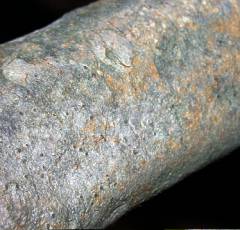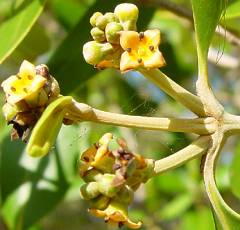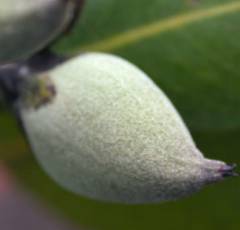Avicennia marina
Avicennia marina (Forssk.) Vierh. var. marina
Family: Avicenniaceae
Common names: white mangrove (Eng.); witseebasboom (Afr.); mangal, towozi, txomahati (Xironga); isikhungathi (isiXhosa, isiZulu) - these from Van Wyk et al. (2011); Gomes e Sousa (1967) gives nhamesso (Xironga) and mussu (Quimuane) for Mozambique. The Kiswahili name Uchu (coastal Kenyan) and Mtswi (Giriyama) are recorded on herbarium specimens, as are many other vernacular names within its vast range.
SA Tree No: 669
Introduction
Every travel agent's idea of a tropical paradise involves white, palm-fringed beaches and "the murmur of summer seas" - but what are those trees with the startlingly white trunks between the palms, down by the river mouth? Read on and find out.

Description
Description
Small to medium-sized tree (3-11 m), main trunk straight, up to 76 cm in diameter, with much branched, rounded crown. Bark pale yellowish green, with raised dots, flaking.

Extensive underground root system with 'pencil roots' (pneumatophores or breathing roots) up to 90 mm long, sticking up out of the mud in dense stands spreading out from tree.

Leaves opposite, 30-100 x 12-40 mm, thick, leathery, shiny olive green above, with dense grey hairs beneath, margin entire with sharply or bluntly pointed tip, base narrowing, petiole short (5 mm long).

Flowers creamy yellow, small, in dense round heads in leaf axils or terminally, on short, square stalks, sweetly scented.

Fruit a green, oval, two-valved capsule 20-25 mm diam.; seed developing on the tree, fruit usually splitting after falling; water-dispersed.
Conservation Status
Status
Raimondo et al. (2009) list the white mangrove as being of Least Concern, which is reasonable, given its immense range and abundance where it occurs. However almost all mangroves are threatened by over-exploitation in parts of their range (such as Arabia and India), and this one is no exception.
Distribution and habitat
Distribution description
White mangrove grows on the inland side of tropical and subtropical coastal swamps, along the east coast of Africa from about East London to Sudan (Red Sea coast), on the coasts of Arabia, India, northern Australia and on every island in the Indian Ocean. Another variety, Avicennia marina var. australasica is the world's southernmost mangrove, being reported from the south-eastern tip of Australia near Melbourne, and from New Zealand near Auckland. Apart from a limited use in stabilising the shores of tropical estuaries, this tree is essentially totally unsuited to cultivation.
The genus Avicennia includes between 4 and 14 species, depending on the limits one adopts for a species. As in other widespread mangrove genera, there are different species with non-overlapping distributions in the Atlantic and Indo-Pacific ocean basins.

Derivation of name and historical aspects
History
The first recognizable account of the genus Avicennia was published by Caspar Bauhin (1623), though he confused our tree with a mango, and cited even earlier herbals by, among others, Garcia de Orta, who probably saw both trees in India. A few decades later the white mangrove was well illustrated in Van Rheede's (1678-1693) Hortus Malabaricus, and this work is the source of the generic name used by Linnaeus (1747, 1754). That the earliest published reference should be to an Indian Ocean species and not to an Atlantic one is not remarkable when one considers the route that the early Portuguese and Dutch traders used between Europe and India. Their last landfall in the Atlantic was Madeira, the Azores or the Canaries, from where they went almost to Brazil (but not landing anywhere) before turning south-eastwards and rounding the Cape. They thus sailed past all the Avicennia localities in the Atlantic without stopping, and only made landfall in the Indian Ocean. However, other early explorers sailed to the Caribbean, and A. germinans (L.) L. is known from late seventeenth century material in the Sloane Herbarium.
The genus Avicennia is named after one of the greatest luminaries of mediaeval Islamic science, the Persian physician, naturalist, philosopher and mathematician Abu Ali Husain Ibn Abd Allah (Abu Ali Alhosain Ibn Sina, 980-1037 AD). Later generations of Western academics Latinized his name as 'Avicenna'. The specific epithet marina refers to the habitat of the white mangrove, at the edge of the sea.
Ecology
Ecology
This is a pioneer mangrove, and among the first to colonise open tidal habitats, later being restricted to the more inland parts of the swamp where conditions are at their most extreme. Unusually among mangroves, these trees can exude excess salt through their leaves, and it is not uncommon to find salt crystals adhering to the leaves.
As with all proper mangroves, the seeds germinate on the tree, and what is dropped and dispersed is actually a seedling. This can travel far and wide propelled by wind and ocean currents, and so it is to be expected that trees are found wherever a suitable habitat exists. This also explains the lack of overlap between the Atlantic and Indo-Pacific ranges of the genus.
Pollinators and insect interactions are unknown, but Palmer & Pitman (1973) note that the tree provides nesting sites for several coastal bird species.
Uses
Use
Gomes e Sousa (1967) reports that in Mozambique this species was useful in stabilizing banks of estuaries in salty water, and that it has tannin-rich bark. The bark has been used for tanning and for the preparation of a brown dye. Around Kosi Bay, the leafy branches provide closures for fish traps, and further north in East Africa the hard, yellow-brown wood is used for making the ribs of dhows (traditional Arab sailing vessel). Mabberley (2008) reports that the timber, like that of many mangroves, is resistant to termites. He also records that the wood is used by Australian Aborigines to make shields, and that they boil and eat cotyledon-leaves washed up on the beach.
Growing Avicennia marina
Grow
You have a small, cold, water-wise garden? Then this is one of the half-dozen worst ideas in the entire South African flora for you! Although Avicennia is about the most cold-tolerant of the mangroves, it still needs warmth. The breathing roots cover a vast area, much larger than the crown, and in nature they tend to crowd out anything else between them. And finally, being a mangrove this tree needs prodigious amounts of water. Curiously, experiments at the then University of Durban-Westville (G.S. Naidoo, pers. comm.) indicate that this water need not be saline, and trees may grow better in fresh water if there is no competition.
With that background it is hardly surprising that I have never seen nor heard of anyone trying to grow the white mangrove in a garden. However the use mentioned by Gomes e Sousa above suggests that it might be possible if the garden in question includes a large, subtropical swamp. Before experimenting, please be aware that every swamp where this tree grows naturally in South Africa is protected and you will need a permit to collect seed in this country, or an import permit and phytosanitary certificates to bring seed in from elsewhere in its range.
Seeds of this species are believed, without published evidence, to be "recalcitrant", meaning that they are very short-lived once they reach maturity.The seeds germinate in the fruit while still on the tree. I have never seen a diseased tree of this species. Soil requirements for this tree are unknown, but probably include anaerobic mud.
References
- Bauhin, C. 1623. Pinax Theatri Botanici. Impensis Joannis Regis, Basel.
- Berjak, P., Campbell, G.K., Huckett, B.I. & Pammenter, N.W. 1977. In the mangroves of southern Africa. Wildlife Society of South Africa, Durban.
- Boon, R. 2010. Pooley's Trees of eastern South Africa. Flora & Fauna Publications Trust, Durban.
- Coates Palgrave, M. 2002. Keith Coates Palgrave's Trees of southern Africa. Struik, Cape Town.
- Duke, N.C. 1991. A systematic revision of the mangrove genus Avicennia (Avicenniaceae) in Australasia. Australian Systematic Botany 4: 299-324.
- Gillett, J.B. & McDonald, P.G. 1970. A numbered check-list of trees shrubs and noteworthy lianes indigenous to Kenya. Government Printer, Nairobi.
- Glen, H.F. 2004. SAPPI What's in a Name? Jacana, Johannesburg.
- Gomes e Sousa, A. 1967. Dendrologia de Moçambique. Instituto de Investigação Agronômica de Moçambique, Lourenço Marques.
- Linnaeus, C. 1747. Flora Zeylanica. Salvius, Stockholm.
- Linnaeus, C. 1754. Genera Plantarum edn 5. Salvius, Stockholm.
- Mabberley, D.J. 2008. Mabberley's Plant-book, edn 3. Cambridge University Press, Cambridge.
- Palmer, E. & Pitman, N. 1973. Trees of southern Africa. Balkema, Cape Town.Raimondo, D., Von Staden, L. Foden, W., Victor, J.E., Helme, N.A., Turner, R.C., Kamundi, D.A. & Manyama, P.A. (2009). Red List of South African Plants 2009. Strelitzia 25. South African National Biodiversity Institute, Pretoria.
- Van Rheede tot Drakenstein, H. 1678--1693. Hortus Indicus Malabaricus. Johannes van Someren, Amsterdam.
- Van Wyk, A.E., Van den Berg, E., Coates Palgrave, M. & Jordaan, M. 2011. Dictionary of names for southern African trees. Briza Academic, Pretoria.
- Van Wyk, A.E. & Van Wyk, P. 1997. Field guide to trees of southern Africa. Struik, Cape Town.
Credits
H.F. Glen
Kwazulu-Natal Herbarium
June 2011
Plant Attributes:
Plant Type: Tree
SA Distribution: Eastern Cape, KwaZulu-Natal
Soil type: Sandy, Clay, Loam, Brack/saline
Flowering season: Spring, Early Summer, Late Summer
PH: Alkaline, Neutral
Flower colour: Cream, Yellow
Aspect: Full Sun
Gardening skill: Challenging
Special Features:
Horticultural zones







Rate this article
Article well written and informative
Rate this plant
Is this an interesting plant?
Login to add your Comment
Back to topNot registered yet? Click here to register.